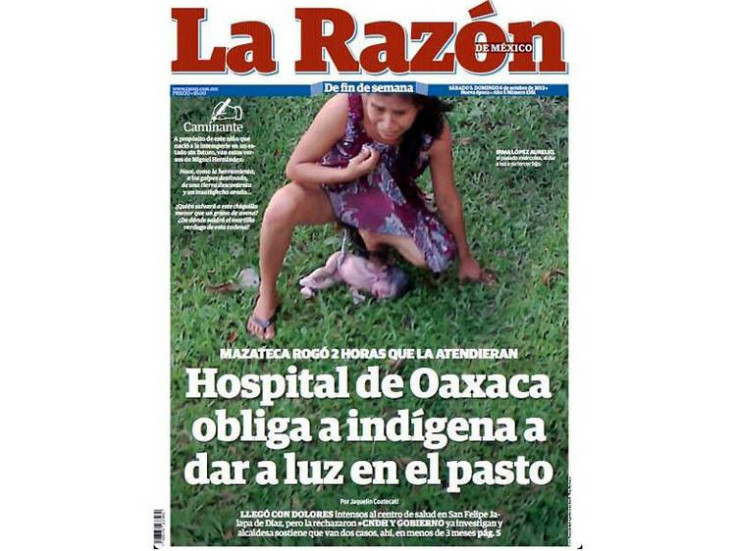Irma Lopez Aurelio Gives Birth Outside Mexican Clinic After Being Denied Immediate Medical Attention [PHOTO]

The screams of 28-year-old Irma Lopez Aurelio in labor were heard throughout the town of San Felipe Jalapa de Diaz, Mexico as she gave birth on a patch of grass outside the Oaxaca medical clinic after being denied proper care and treatment.
Aurelio made the front page of La Razon de Mexico newspaper, which printed the disturbing image of the mother and her newborn with the umbilical cord still attached. The photo, which was been widespread nationally in Mexico and overseas, has stirred up controversy as to why Aurelio was forced to give birth outside the health clinic.
Aurelio and her husband, an indigenous couple from the Sierra Mazateca region in Mexico, traveled together hand-in-hand on the pitch black road before dawn on Oct. 2 to seek emergency medical attention. The mother of two, fully dilated as her water broke, was briefly examined by medical staffers but was not admitted to the clinic, according to La Razon.
The Oaxaca staffers claimed that they were too shorthanded — due to the partial work stoppage in Mexico — to treat the pregnant woman. In full labor pains, Aurelio went outside of the clinic and continued to pace back and forth to ease her pain, the NY Daily News reports. After two hours of hoping that a nurse or doctor would signal them to come into the clinic, Aurelio dropped down on one knee on the lawn outside the facility and began to push.
Eloy Pacheco Lopez, a bystander, heard the screams of Aurelio when he ran outside and took the controversial photo of her moments later after she gave birth.

The photo was first posted on Lopez's Facebook under the caption "after waiting and demanding attention for two hours, she gave birth in the yard of the hospital after being ignored by personnel under the direction of the supposed doctor Adrian René Cruz Cabrera,” according to the Latin Times. The controversial photo of Aurelio and her son went viral as it was picked up by La Razon and later posted on Twitter, where it stirred debate on the efficiency of personnel and health authorities in the Oaxaca clinic.
It was only after Aurelio had finally given birth that the clinic's staff rushed to help her and give her the proper care and treatment. Health officials in Mexico are currently investigating why the pregnant woman did not receive immediate medical treatment. The clinic staff suggested a linguistic barrier led to the confusion and further delay of immediate medical attention.
The indigenous couple does not speak Spanish and could only understand the word “no,” according to La Razon. The staff members allegedly went outside to look for Aurelio but said that they couldn’t find her, although she was directly outside the clinic.
“When they went out to look for her they didn't find her,” said German Tenorio, Oaxaca's health secretary, to a local TV station. However, he does not believe the language barrier justifies the medical negligence. According to Tenorio, although Aurelio has “problems understanding Spanish,” it is inexcusable to validate the mix-up.
This is not the first time that the Oaxaca clinic has been placed under scrutiny. According to Clarin, Silvia Flores, mayor of San Felipe Jalapa de Diaz, said it was the second time in a year that a woman had to give birth to a child on the clinic’s grass. The Oaxaca Human Rights Commission has opened up an investigation and submitted a request to obtain information from the health authorities to examine the negligence of this medical facility.



























